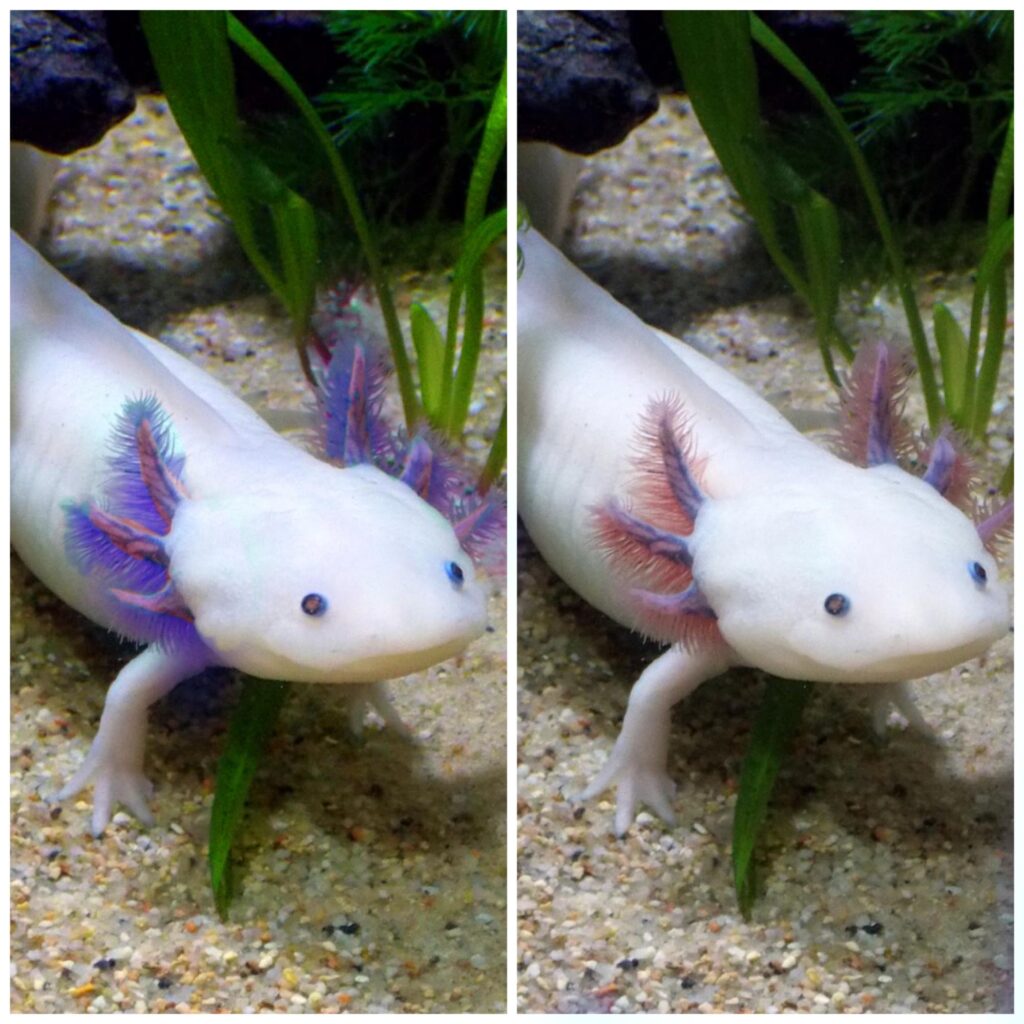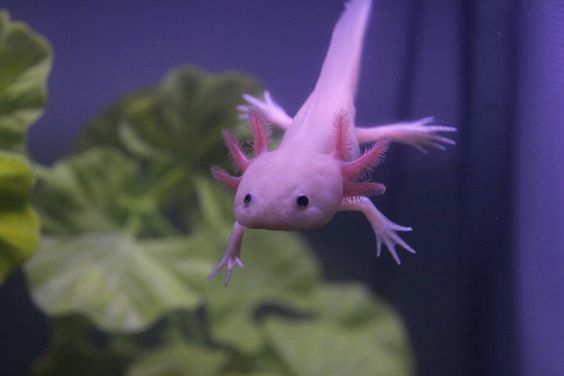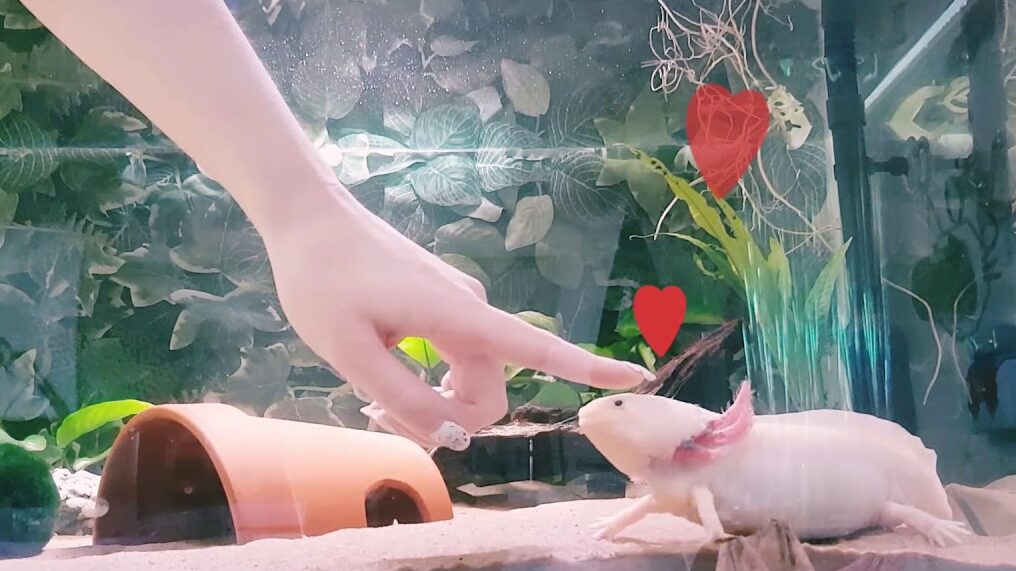
Axolotls, those enigmatic aquatic beings, indeed undergo mesmerizing color changes throughout their lives. This phenomenon is not only visually striking but also reflects the adaptability of axolotls to their surroundings. The shifts in coloration are not arbitrary; they are intricately linked to factors like genetics, environment, and developmental stages. “Do Axolotl Change Color”
How Do Axolotls Change Color
The captivating process of axolotl color change is orchestrated by a combination of genetic predispositions and environmental influences. Unlike some animals that undergo metamorphosis, axolotls retain their aquatic larval form throughout their lives. The vibrant hues that grace their skin are the result of intricate interactions between their genetic makeup and the conditions in which they live.
The coloration of axolotls, whether it’s a black melanoid axolotl or a lavender axolotl, can change due to various factors. Genetic variations, age, and environmental conditions play roles in color changes. Stress, mood, and even diet can influence their vibrant hues. Observing these changes enhances our understanding and care for these captivating aquatic creatures.
Factors Influencing Axolotl Color Change
Several factors contribute to the kaleidoscopic display of colors in axolotls. At the forefront is the influence of genetics, determining the baseline coloration and potential variations. Environmental factors play an equally crucial role, with changes in water quality, temperature, and light influencing the intensity and pattern of colors exhibited by these creatures.
Genetics
The genetic code of axolotls plays a pivotal role in shaping their color palette. Specific genes dictate the baseline color, whether it’s the wild-type appearance, the absence of pigmentation in albinos, or the melanoid variant with enhanced dark pigments. Understanding these genetic markers provides valuable insights into the inheritance patterns of color traits in axolotls.
Environmental Factors
Axolotls are not passive recipients of their surroundings; they actively respond to changes in their environment. Factors such as the quality of water, ambient temperature, and even the type of substrate in their tank can influence their coloration. This responsiveness showcases their remarkable ability to adapt and thrive in diverse aquatic habitats.
Reasons Why Axolotls Change Color
The mesmerizing color changes in axolotls are not mere happenstance but serve distinct purposes rooted in their biology. Understanding the reasons behind these transformations unveils the intricate strategies these aquatic beings employ to navigate their environment. From camouflage to communication during mating rituals, the spectrum of colors exhibited by axolotls is a testament to their adaptability and survival instincts.
Camouflage Strategies
One of the primary reasons axolotls change color is to employ effective camouflage strategies. In their natural habitats, which include lakes, ponds, and slow-moving waters, axolotls encounter a diverse array of backgrounds. Their ability to adjust their skin color to blend seamlessly with their surroundings helps them evade predators and ambush prey. This chameleon-like adaptation showcases the brilliance of nature’s design, allowing axolotls to become nearly invisible to both potential threats and potential meals.
Mating Rituals
Color changes in axolotls play a crucial role in their intricate mating rituals. When these aquatic creatures are in the throes of courtship, their skin color undergoes dynamic shifts. These changes serve as a form of communication, allowing axolotls to convey their readiness to mate, establish dominance, or express receptiveness to potential mates. The vibrant displays become a visual language, ensuring effective interaction between individuals during the complex dance of courtship.
At What Age Axolotls Change Color
The age at which axolotls undergo color changes is a fascinating aspect of their development. Typically, these aquatic creatures begin to exhibit noticeable shifts in coloration as they transition from their juvenile stage to adulthood. This transformative process, influenced by both genetic factors and environmental conditions, unfolds gradually, providing enthusiasts with a captivating spectacle of nature’s artistry.
The age at which axolotls change color varies. While genetics play a role, environmental factors, stress, and diet also contribute. “Is Sand OK for Axolotls?” becomes a pivotal question when considering their habitat. Providing an appropriate environment, including the Best Aquarium Air Stones for Axolotl, promotes their well-being and can influence the timing of their color transformation.
Juvenile Coloration
In their early stages of life, axolotls display distinctive juvenile coloration. Juvenile axolotls often exhibit a range of colors, from muted earth tones to brighter hues. The specific coloration can vary based on the genetics of the individual axolotl and the conditions of their habitat. As they navigate their aquatic world, juvenile axolotls use their unique colors not only for camouflage but also as a means of communication within their community.
Observing juvenile coloration in axolotls is like witnessing the opening chapters of a captivating story. The initial colors serve as a canvas upon which the narrative of their life begins, promising to evolve and transform as they mature.
Adult Coloration
As axolotls reach adulthood, their coloration undergoes significant changes. The vibrant and dynamic hues associated with adult axolotls often emerge, showcasing the full spectrum of their genetic predispositions. This transformation is not only aesthetically captivating but also serves practical purposes in the context of their environment and social interactions.
Adult axolotls may develop more pronounced patterns and color variations that play a role in mate selection, territory establishment, and communication. The transition from juvenile coloration to the distinctive hues of adulthood is a testament to the complex interplay between genetics and environmental influences, reflecting the adaptability of axolotls as they navigate the various stages of their aquatic lives.
Is Changing Color a Health Issue in Axolotls

The color changes in axolotls can be a source of intrigue for enthusiasts, but it’s crucial to discern between normal variations and changes that might indicate underlying health issues. While axolotls are known for their dynamic coloration, sudden or extreme shifts may signal potential health concerns. Monitoring these changes is a vital aspect of responsible axolotl care, ensuring the well-being of these captivating aquatic creatures.
Normal vs. Abnormal Changes
Distinguishing between normal and abnormal color changes is key to assessing the health of axolotls. Normal changes often occur during growth, maturation, or in response to environmental factors. However, abrupt, drastic alterations in coloration might be indicative of stress, illness, or environmental imbalances. Understanding the baseline coloration of individual axolotls and being attuned to subtle shifts aids in identifying deviations that may require further investigation.
Common Health-Related Color Changes
Certain color changes in axolotls are commonly associated with specific health conditions. For instance, paleness or loss of pigmentation can be indicative of stress, poor water quality, or even issues with the axolotl’s diet. Conversely, abnormal darkening or the appearance of lesions may signal infections or skin disorders. Regular health assessments, including observing changes in color, allow caretakers to intervene promptly, addressing potential health issues before they escalate.
Addressing health-related color changes involves a holistic approach, including maintaining optimal tank conditions, providing a balanced diet, and promptly consulting a veterinarian when needed. Being proactive in monitoring and addressing these changes ensures that axolotls thrive in a healthy and vibrant state. In the colorful tapestry of axolotl care, understanding the nuances of color changes becomes a valuable tool for safeguarding the health and vitality of these unique aquatic companions.
FAQs
1. Why do axolotls change color?
Axolotls change color for various reasons, including genetic factors, environmental adaptations, and hormonal changes.
2. At what age do axolotls typically start changing color?
Color changes in axolotls often begin as they transition from juveniles to adults, usually around 12-18 months.
3. Are certain colors more common in axolotls?
Yes, certain colors are more prevalent due to genetic factors. Common colors include wild type, leucistic, albino, and melanoid.
4. Can stress cause axolotls to change color?
Yes, stress can lead to temporary color changes in axolotls. It’s crucial to identify and address the source of stress.
5. Do axolotls change color during mating?
Yes, axolotls often exhibit color changes during mating rituals. This is part of their communication and courtship behavior.
6. Is it normal for axolotls to change color over time?
Yes, it’s normal for axolotls to experience color changes as they grow and adapt to their environment.
7. How can I enhance the color of my axolotl?
Providing a well-balanced diet, maintaining a clean environment, and ensuring proper tank conditions can enhance axolotl coloration.
8. Are there specific color changes that indicate illness?
Sudden, drastic color changes or the appearance of unusual markings can be signs of illness. Consult a veterinarian if concerned.
9. Can axolotls change color in response to light?
Yes, exposure to light, particularly natural sunlight or specific artificial lighting, can influence axolotl coloration.
10. How long does it take for an axolotl to fully change color?
The complete color change from juvenile to adult form may take several months, with variations among individual axolotls.
Conclusion
In conclusion, the ever-changing colors of axolotls unveil a captivating narrative of their lives, from the early stages of juvenile exploration to the mature intricacies of adulthood. The dynamic palette exhibited by these aquatic wonders is a result of a delicate dance between genetic predispositions and the environmental tapestry in which they thrive. From camouflage strategies that render them nearly invisible to predators, to vibrant displays that communicate during intricate mating rituals, every shift in color serves a purpose deeply embedded in their evolutionary history.
However, as stewards of these unique creatures, it is incumbent upon enthusiasts to discern between the normal, awe-inspiring transformations and those that may indicate underlying health issues. Monitoring color changes becomes a vital aspect of responsible care, allowing us to intervene promptly and ensure the well-being of these aquatic companions.
With 3 years of devoted companionship alongside my aquatic friend, Bob, I’ve gained profound insights into the captivating world of fishkeeping. From understanding behavior to ensuring optimal health, my journey with Bob has enriched my expertise in all things aquatic.




Pingback: Can Axolotl Live with Other Fish - Fish Hue
Pingback: Axolotl Temperature: What's Best and How to Maintain - Fish Hue